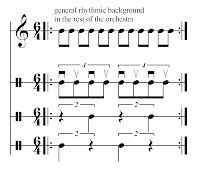Which brings me to the drum beat. If you substitute the tam-tam with snare drum and the guiro with hi-hat it sure sounds and looks a lot like this:
 |
| a "characteristic drum beat" from Wikipedia |
So to me, the "Procession" sounds like a whole bunch of triplets over a huge back beat. Because that's essentially what it is. The notation is slick and misleading, but the effect is very plain.





Word. Stravinsky rocks. Didn't you know that?
ReplyDeleteI like the use of the word "characteristic" without reference to anything. Like using the word "conducive" by itself. Characteristic drum beats are often conducive.
ReplyDelete